Educational Theories Report: Teaching Methods and ICT in Education
VerifiedAdded on 2023/04/21
|8
|2091
|186
Report
AI Summary
This report analyzes two student narratives and proposes suitable teaching methods to address their writing challenges. For Harper, whose work is marred by spelling and grammatical errors, the report suggests a peer response and editing method combined with a student-chosen text approach. This involves peer review and reading materials of interest to improve language skills. For Madison, who demonstrates creativity but lacks technical writing skills, the report recommends vocabulary building and writer's workshop methods. The report also explores the benefits of ICT in education, including videos, computer-based games, and mobile apps, to enhance teaching and learning experiences. The comparison section contrasts the suggested approaches, discussing the limitations of each, such as potential biases in peer review and the challenges of vocabulary acquisition. The report concludes by emphasizing the importance of student-centered learning and the effective integration of technology to improve language skills and overall educational outcomes.
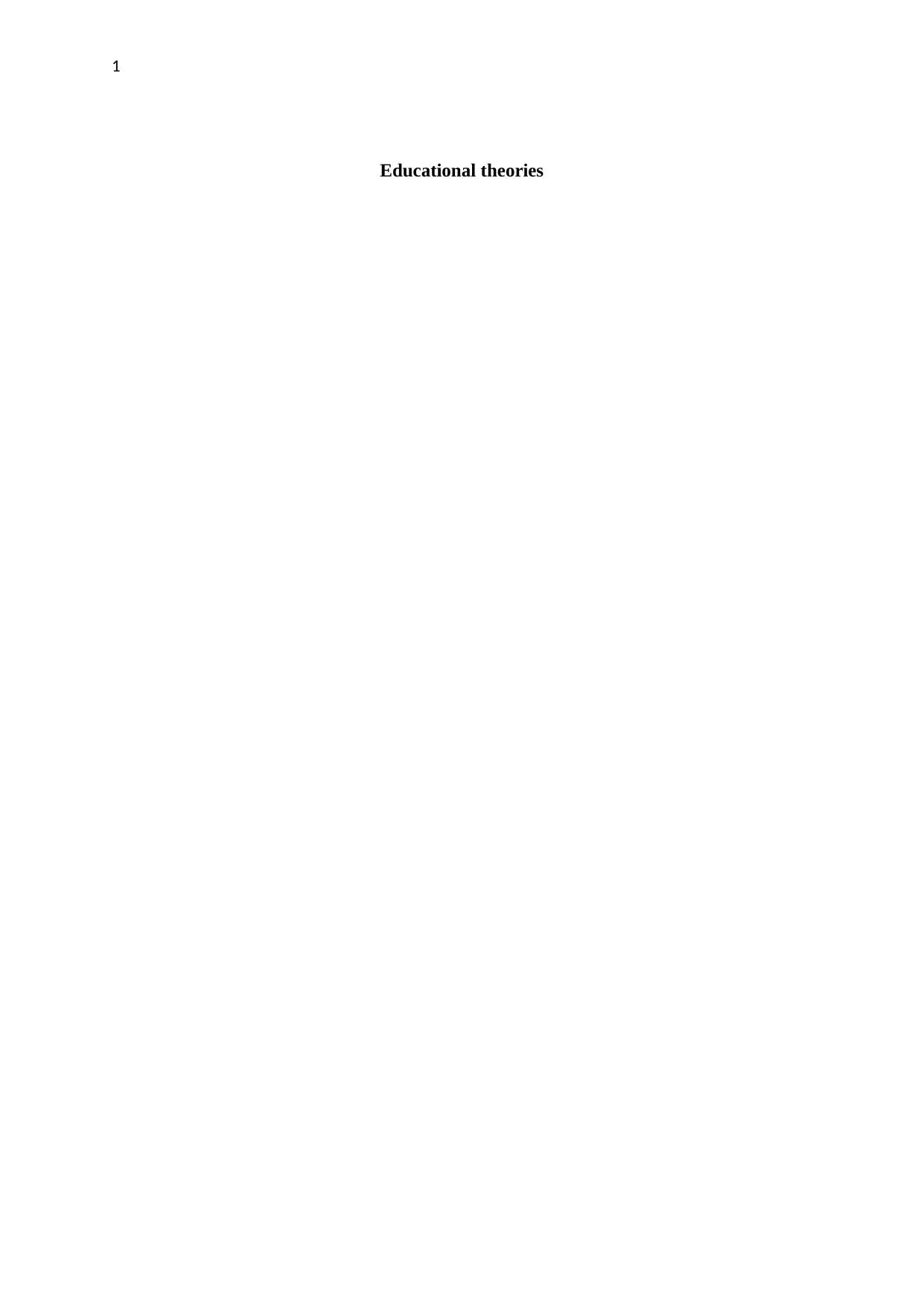
1
Educational theories
Educational theories
Paraphrase This Document
Need a fresh take? Get an instant paraphrase of this document with our AI Paraphraser
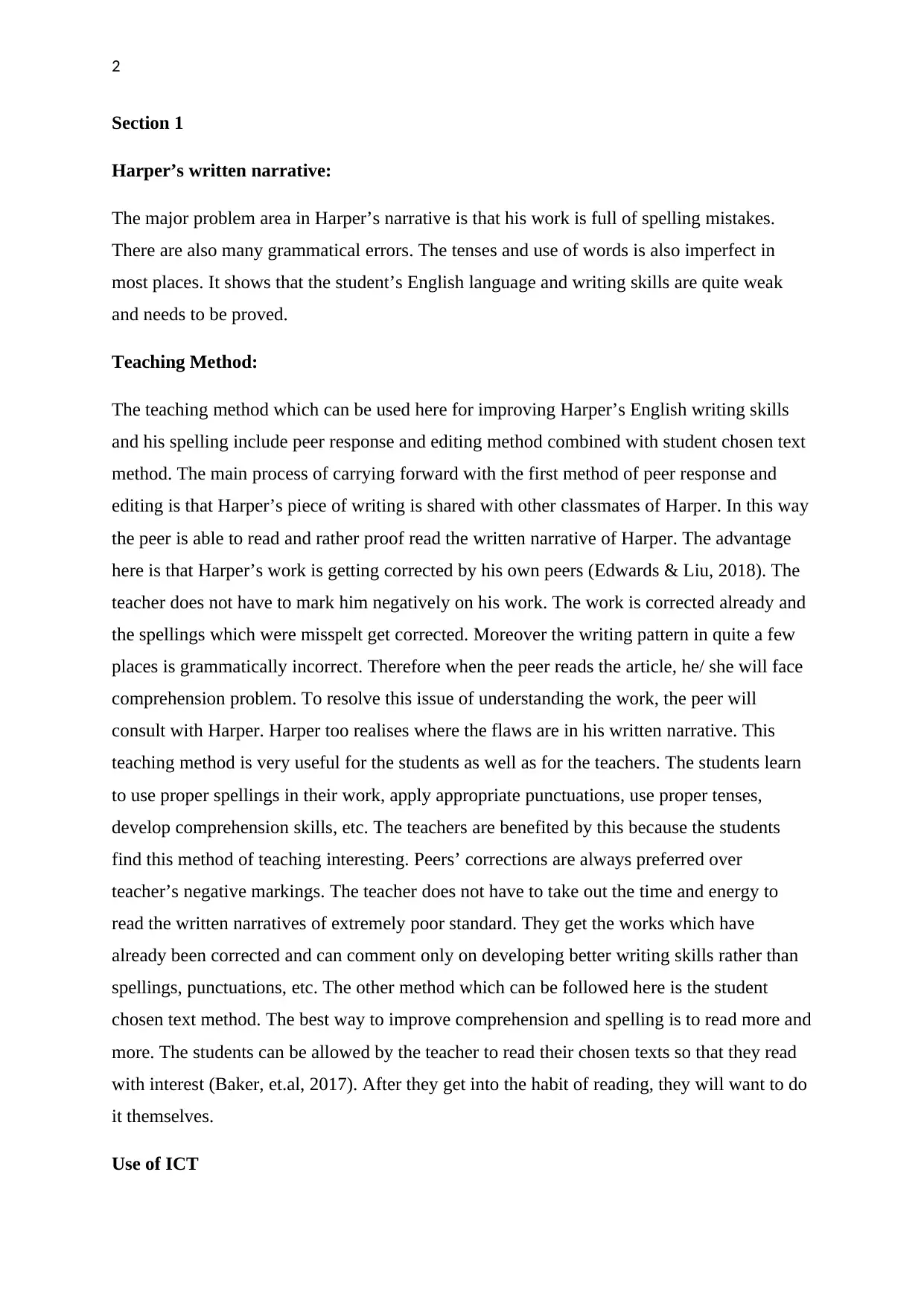
2
Section 1
Harper’s written narrative:
The major problem area in Harper’s narrative is that his work is full of spelling mistakes.
There are also many grammatical errors. The tenses and use of words is also imperfect in
most places. It shows that the student’s English language and writing skills are quite weak
and needs to be proved.
Teaching Method:
The teaching method which can be used here for improving Harper’s English writing skills
and his spelling include peer response and editing method combined with student chosen text
method. The main process of carrying forward with the first method of peer response and
editing is that Harper’s piece of writing is shared with other classmates of Harper. In this way
the peer is able to read and rather proof read the written narrative of Harper. The advantage
here is that Harper’s work is getting corrected by his own peers (Edwards & Liu, 2018). The
teacher does not have to mark him negatively on his work. The work is corrected already and
the spellings which were misspelt get corrected. Moreover the writing pattern in quite a few
places is grammatically incorrect. Therefore when the peer reads the article, he/ she will face
comprehension problem. To resolve this issue of understanding the work, the peer will
consult with Harper. Harper too realises where the flaws are in his written narrative. This
teaching method is very useful for the students as well as for the teachers. The students learn
to use proper spellings in their work, apply appropriate punctuations, use proper tenses,
develop comprehension skills, etc. The teachers are benefited by this because the students
find this method of teaching interesting. Peers’ corrections are always preferred over
teacher’s negative markings. The teacher does not have to take out the time and energy to
read the written narratives of extremely poor standard. They get the works which have
already been corrected and can comment only on developing better writing skills rather than
spellings, punctuations, etc. The other method which can be followed here is the student
chosen text method. The best way to improve comprehension and spelling is to read more and
more. The students can be allowed by the teacher to read their chosen texts so that they read
with interest (Baker, et.al, 2017). After they get into the habit of reading, they will want to do
it themselves.
Use of ICT
Section 1
Harper’s written narrative:
The major problem area in Harper’s narrative is that his work is full of spelling mistakes.
There are also many grammatical errors. The tenses and use of words is also imperfect in
most places. It shows that the student’s English language and writing skills are quite weak
and needs to be proved.
Teaching Method:
The teaching method which can be used here for improving Harper’s English writing skills
and his spelling include peer response and editing method combined with student chosen text
method. The main process of carrying forward with the first method of peer response and
editing is that Harper’s piece of writing is shared with other classmates of Harper. In this way
the peer is able to read and rather proof read the written narrative of Harper. The advantage
here is that Harper’s work is getting corrected by his own peers (Edwards & Liu, 2018). The
teacher does not have to mark him negatively on his work. The work is corrected already and
the spellings which were misspelt get corrected. Moreover the writing pattern in quite a few
places is grammatically incorrect. Therefore when the peer reads the article, he/ she will face
comprehension problem. To resolve this issue of understanding the work, the peer will
consult with Harper. Harper too realises where the flaws are in his written narrative. This
teaching method is very useful for the students as well as for the teachers. The students learn
to use proper spellings in their work, apply appropriate punctuations, use proper tenses,
develop comprehension skills, etc. The teachers are benefited by this because the students
find this method of teaching interesting. Peers’ corrections are always preferred over
teacher’s negative markings. The teacher does not have to take out the time and energy to
read the written narratives of extremely poor standard. They get the works which have
already been corrected and can comment only on developing better writing skills rather than
spellings, punctuations, etc. The other method which can be followed here is the student
chosen text method. The best way to improve comprehension and spelling is to read more and
more. The students can be allowed by the teacher to read their chosen texts so that they read
with interest (Baker, et.al, 2017). After they get into the habit of reading, they will want to do
it themselves.
Use of ICT
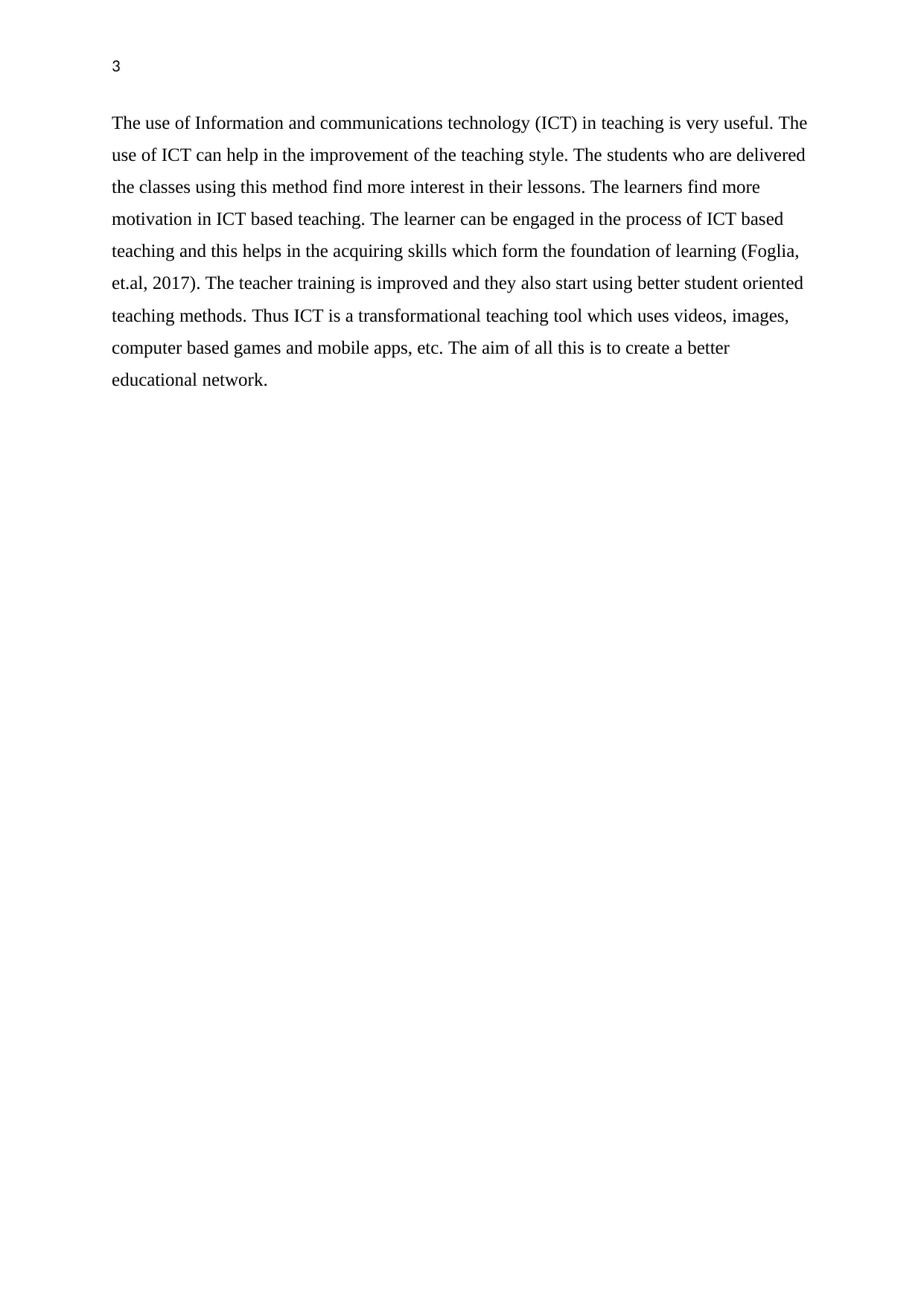
3
The use of Information and communications technology (ICT) in teaching is very useful. The
use of ICT can help in the improvement of the teaching style. The students who are delivered
the classes using this method find more interest in their lessons. The learners find more
motivation in ICT based teaching. The learner can be engaged in the process of ICT based
teaching and this helps in the acquiring skills which form the foundation of learning (Foglia,
et.al, 2017). The teacher training is improved and they also start using better student oriented
teaching methods. Thus ICT is a transformational teaching tool which uses videos, images,
computer based games and mobile apps, etc. The aim of all this is to create a better
educational network.
The use of Information and communications technology (ICT) in teaching is very useful. The
use of ICT can help in the improvement of the teaching style. The students who are delivered
the classes using this method find more interest in their lessons. The learners find more
motivation in ICT based teaching. The learner can be engaged in the process of ICT based
teaching and this helps in the acquiring skills which form the foundation of learning (Foglia,
et.al, 2017). The teacher training is improved and they also start using better student oriented
teaching methods. Thus ICT is a transformational teaching tool which uses videos, images,
computer based games and mobile apps, etc. The aim of all this is to create a better
educational network.
⊘ This is a preview!⊘
Do you want full access?
Subscribe today to unlock all pages.

Trusted by 1+ million students worldwide
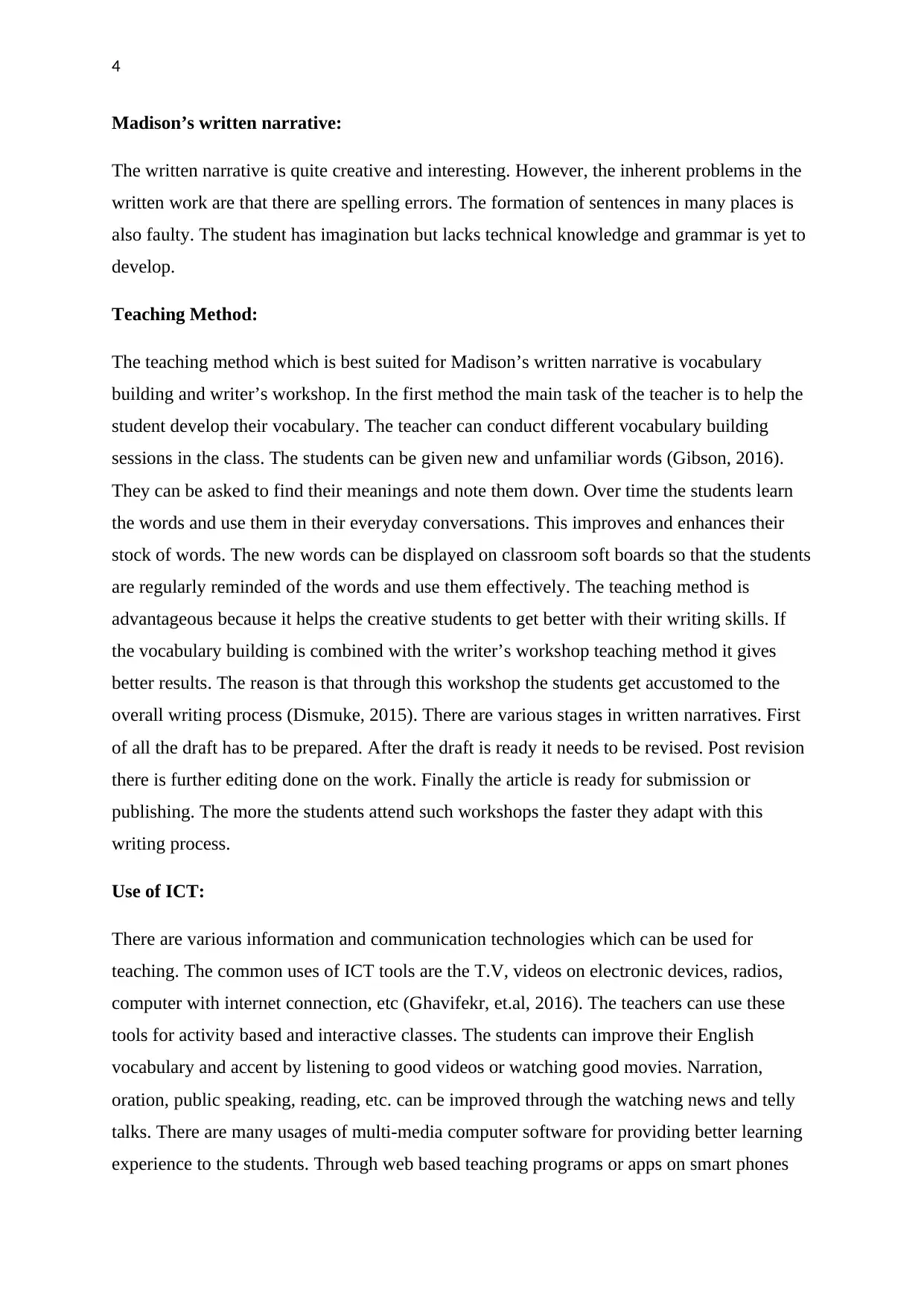
4
Madison’s written narrative:
The written narrative is quite creative and interesting. However, the inherent problems in the
written work are that there are spelling errors. The formation of sentences in many places is
also faulty. The student has imagination but lacks technical knowledge and grammar is yet to
develop.
Teaching Method:
The teaching method which is best suited for Madison’s written narrative is vocabulary
building and writer’s workshop. In the first method the main task of the teacher is to help the
student develop their vocabulary. The teacher can conduct different vocabulary building
sessions in the class. The students can be given new and unfamiliar words (Gibson, 2016).
They can be asked to find their meanings and note them down. Over time the students learn
the words and use them in their everyday conversations. This improves and enhances their
stock of words. The new words can be displayed on classroom soft boards so that the students
are regularly reminded of the words and use them effectively. The teaching method is
advantageous because it helps the creative students to get better with their writing skills. If
the vocabulary building is combined with the writer’s workshop teaching method it gives
better results. The reason is that through this workshop the students get accustomed to the
overall writing process (Dismuke, 2015). There are various stages in written narratives. First
of all the draft has to be prepared. After the draft is ready it needs to be revised. Post revision
there is further editing done on the work. Finally the article is ready for submission or
publishing. The more the students attend such workshops the faster they adapt with this
writing process.
Use of ICT:
There are various information and communication technologies which can be used for
teaching. The common uses of ICT tools are the T.V, videos on electronic devices, radios,
computer with internet connection, etc (Ghavifekr, et.al, 2016). The teachers can use these
tools for activity based and interactive classes. The students can improve their English
vocabulary and accent by listening to good videos or watching good movies. Narration,
oration, public speaking, reading, etc. can be improved through the watching news and telly
talks. There are many usages of multi-media computer software for providing better learning
experience to the students. Through web based teaching programs or apps on smart phones
Madison’s written narrative:
The written narrative is quite creative and interesting. However, the inherent problems in the
written work are that there are spelling errors. The formation of sentences in many places is
also faulty. The student has imagination but lacks technical knowledge and grammar is yet to
develop.
Teaching Method:
The teaching method which is best suited for Madison’s written narrative is vocabulary
building and writer’s workshop. In the first method the main task of the teacher is to help the
student develop their vocabulary. The teacher can conduct different vocabulary building
sessions in the class. The students can be given new and unfamiliar words (Gibson, 2016).
They can be asked to find their meanings and note them down. Over time the students learn
the words and use them in their everyday conversations. This improves and enhances their
stock of words. The new words can be displayed on classroom soft boards so that the students
are regularly reminded of the words and use them effectively. The teaching method is
advantageous because it helps the creative students to get better with their writing skills. If
the vocabulary building is combined with the writer’s workshop teaching method it gives
better results. The reason is that through this workshop the students get accustomed to the
overall writing process (Dismuke, 2015). There are various stages in written narratives. First
of all the draft has to be prepared. After the draft is ready it needs to be revised. Post revision
there is further editing done on the work. Finally the article is ready for submission or
publishing. The more the students attend such workshops the faster they adapt with this
writing process.
Use of ICT:
There are various information and communication technologies which can be used for
teaching. The common uses of ICT tools are the T.V, videos on electronic devices, radios,
computer with internet connection, etc (Ghavifekr, et.al, 2016). The teachers can use these
tools for activity based and interactive classes. The students can improve their English
vocabulary and accent by listening to good videos or watching good movies. Narration,
oration, public speaking, reading, etc. can be improved through the watching news and telly
talks. There are many usages of multi-media computer software for providing better learning
experience to the students. Through web based teaching programs or apps on smart phones
Paraphrase This Document
Need a fresh take? Get an instant paraphrase of this document with our AI Paraphraser
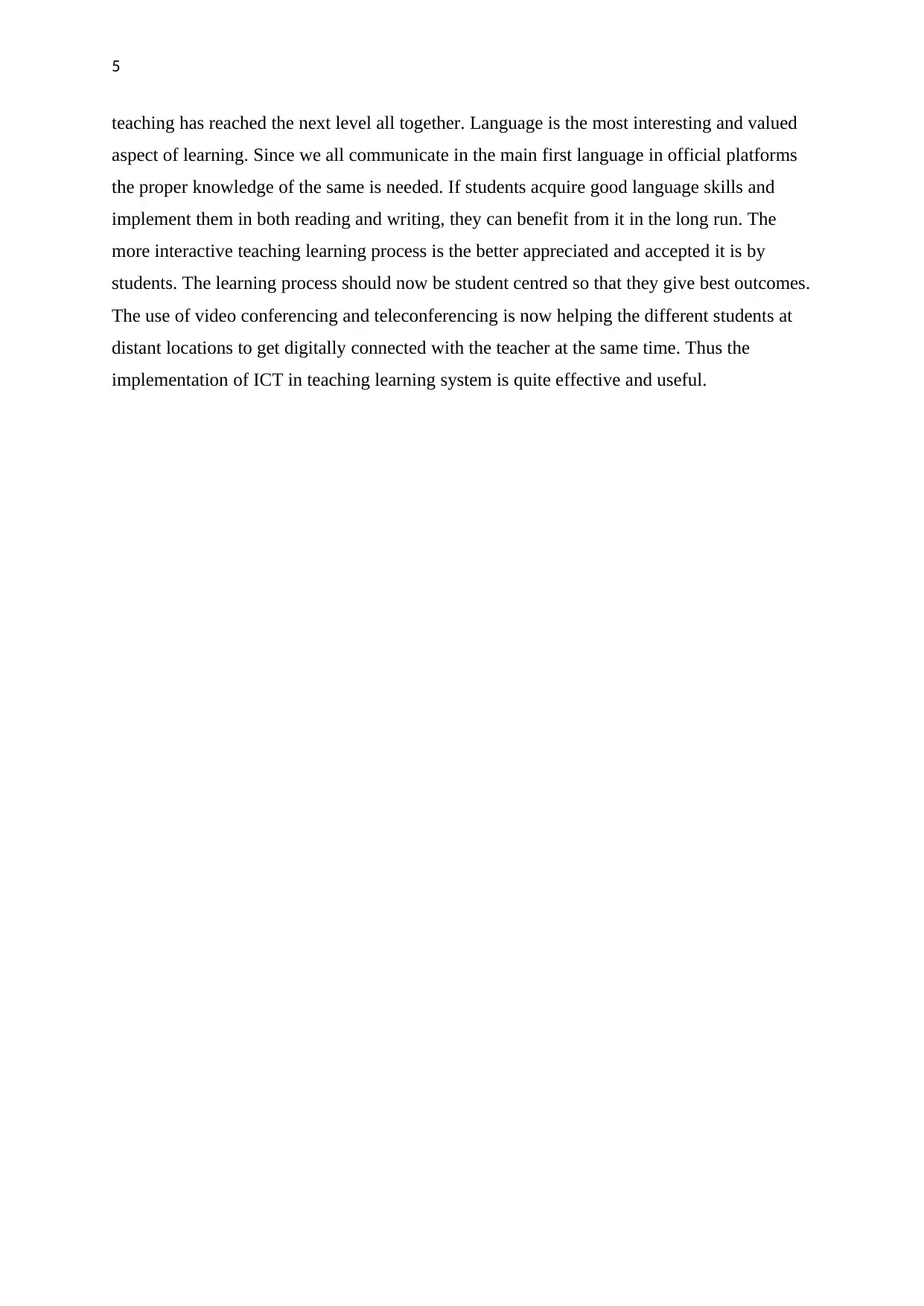
5
teaching has reached the next level all together. Language is the most interesting and valued
aspect of learning. Since we all communicate in the main first language in official platforms
the proper knowledge of the same is needed. If students acquire good language skills and
implement them in both reading and writing, they can benefit from it in the long run. The
more interactive teaching learning process is the better appreciated and accepted it is by
students. The learning process should now be student centred so that they give best outcomes.
The use of video conferencing and teleconferencing is now helping the different students at
distant locations to get digitally connected with the teacher at the same time. Thus the
implementation of ICT in teaching learning system is quite effective and useful.
teaching has reached the next level all together. Language is the most interesting and valued
aspect of learning. Since we all communicate in the main first language in official platforms
the proper knowledge of the same is needed. If students acquire good language skills and
implement them in both reading and writing, they can benefit from it in the long run. The
more interactive teaching learning process is the better appreciated and accepted it is by
students. The learning process should now be student centred so that they give best outcomes.
The use of video conferencing and teleconferencing is now helping the different students at
distant locations to get digitally connected with the teacher at the same time. Thus the
implementation of ICT in teaching learning system is quite effective and useful.
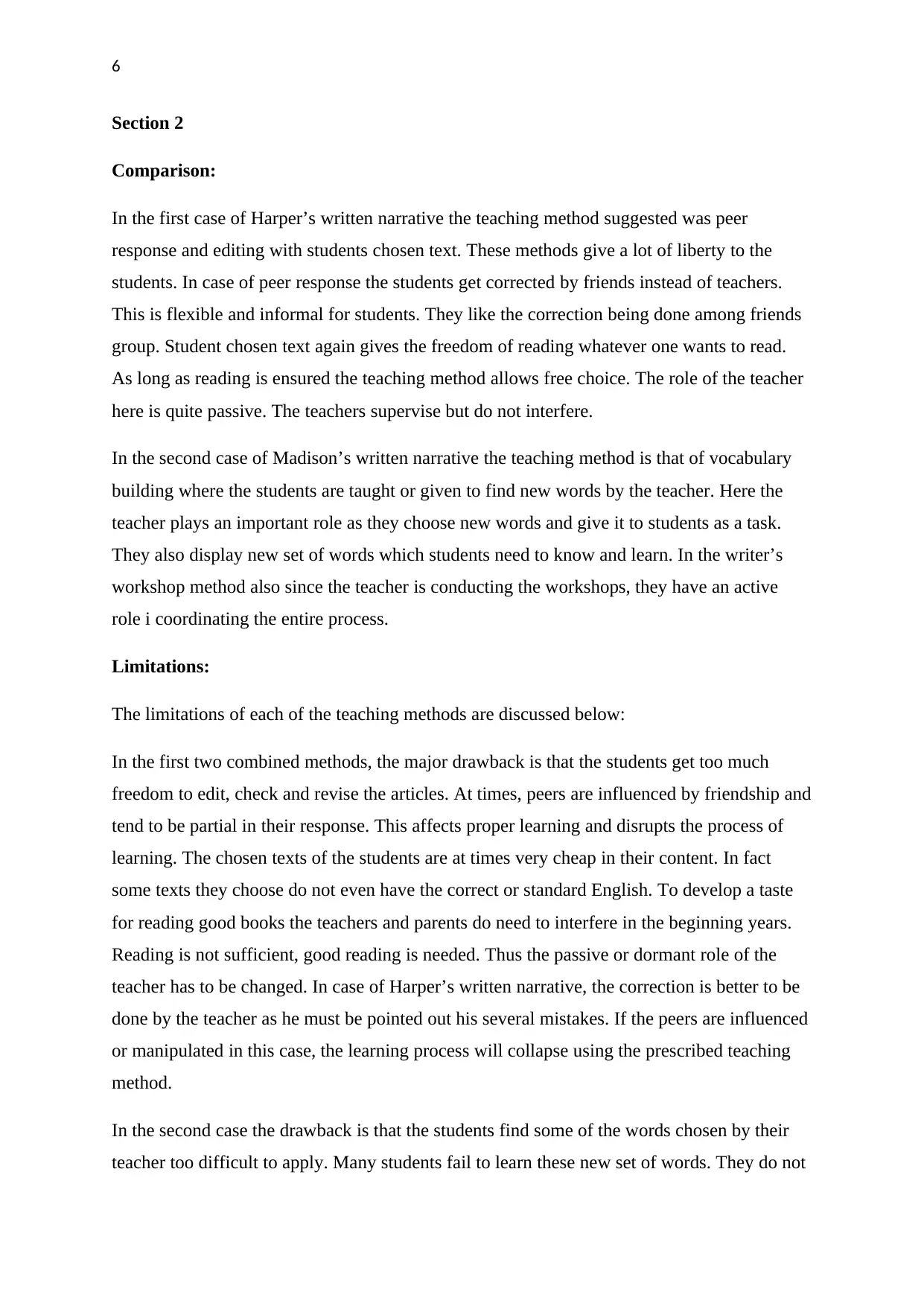
6
Section 2
Comparison:
In the first case of Harper’s written narrative the teaching method suggested was peer
response and editing with students chosen text. These methods give a lot of liberty to the
students. In case of peer response the students get corrected by friends instead of teachers.
This is flexible and informal for students. They like the correction being done among friends
group. Student chosen text again gives the freedom of reading whatever one wants to read.
As long as reading is ensured the teaching method allows free choice. The role of the teacher
here is quite passive. The teachers supervise but do not interfere.
In the second case of Madison’s written narrative the teaching method is that of vocabulary
building where the students are taught or given to find new words by the teacher. Here the
teacher plays an important role as they choose new words and give it to students as a task.
They also display new set of words which students need to know and learn. In the writer’s
workshop method also since the teacher is conducting the workshops, they have an active
role i coordinating the entire process.
Limitations:
The limitations of each of the teaching methods are discussed below:
In the first two combined methods, the major drawback is that the students get too much
freedom to edit, check and revise the articles. At times, peers are influenced by friendship and
tend to be partial in their response. This affects proper learning and disrupts the process of
learning. The chosen texts of the students are at times very cheap in their content. In fact
some texts they choose do not even have the correct or standard English. To develop a taste
for reading good books the teachers and parents do need to interfere in the beginning years.
Reading is not sufficient, good reading is needed. Thus the passive or dormant role of the
teacher has to be changed. In case of Harper’s written narrative, the correction is better to be
done by the teacher as he must be pointed out his several mistakes. If the peers are influenced
or manipulated in this case, the learning process will collapse using the prescribed teaching
method.
In the second case the drawback is that the students find some of the words chosen by their
teacher too difficult to apply. Many students fail to learn these new set of words. They do not
Section 2
Comparison:
In the first case of Harper’s written narrative the teaching method suggested was peer
response and editing with students chosen text. These methods give a lot of liberty to the
students. In case of peer response the students get corrected by friends instead of teachers.
This is flexible and informal for students. They like the correction being done among friends
group. Student chosen text again gives the freedom of reading whatever one wants to read.
As long as reading is ensured the teaching method allows free choice. The role of the teacher
here is quite passive. The teachers supervise but do not interfere.
In the second case of Madison’s written narrative the teaching method is that of vocabulary
building where the students are taught or given to find new words by the teacher. Here the
teacher plays an important role as they choose new words and give it to students as a task.
They also display new set of words which students need to know and learn. In the writer’s
workshop method also since the teacher is conducting the workshops, they have an active
role i coordinating the entire process.
Limitations:
The limitations of each of the teaching methods are discussed below:
In the first two combined methods, the major drawback is that the students get too much
freedom to edit, check and revise the articles. At times, peers are influenced by friendship and
tend to be partial in their response. This affects proper learning and disrupts the process of
learning. The chosen texts of the students are at times very cheap in their content. In fact
some texts they choose do not even have the correct or standard English. To develop a taste
for reading good books the teachers and parents do need to interfere in the beginning years.
Reading is not sufficient, good reading is needed. Thus the passive or dormant role of the
teacher has to be changed. In case of Harper’s written narrative, the correction is better to be
done by the teacher as he must be pointed out his several mistakes. If the peers are influenced
or manipulated in this case, the learning process will collapse using the prescribed teaching
method.
In the second case the drawback is that the students find some of the words chosen by their
teacher too difficult to apply. Many students fail to learn these new set of words. They do not
⊘ This is a preview!⊘
Do you want full access?
Subscribe today to unlock all pages.

Trusted by 1+ million students worldwide
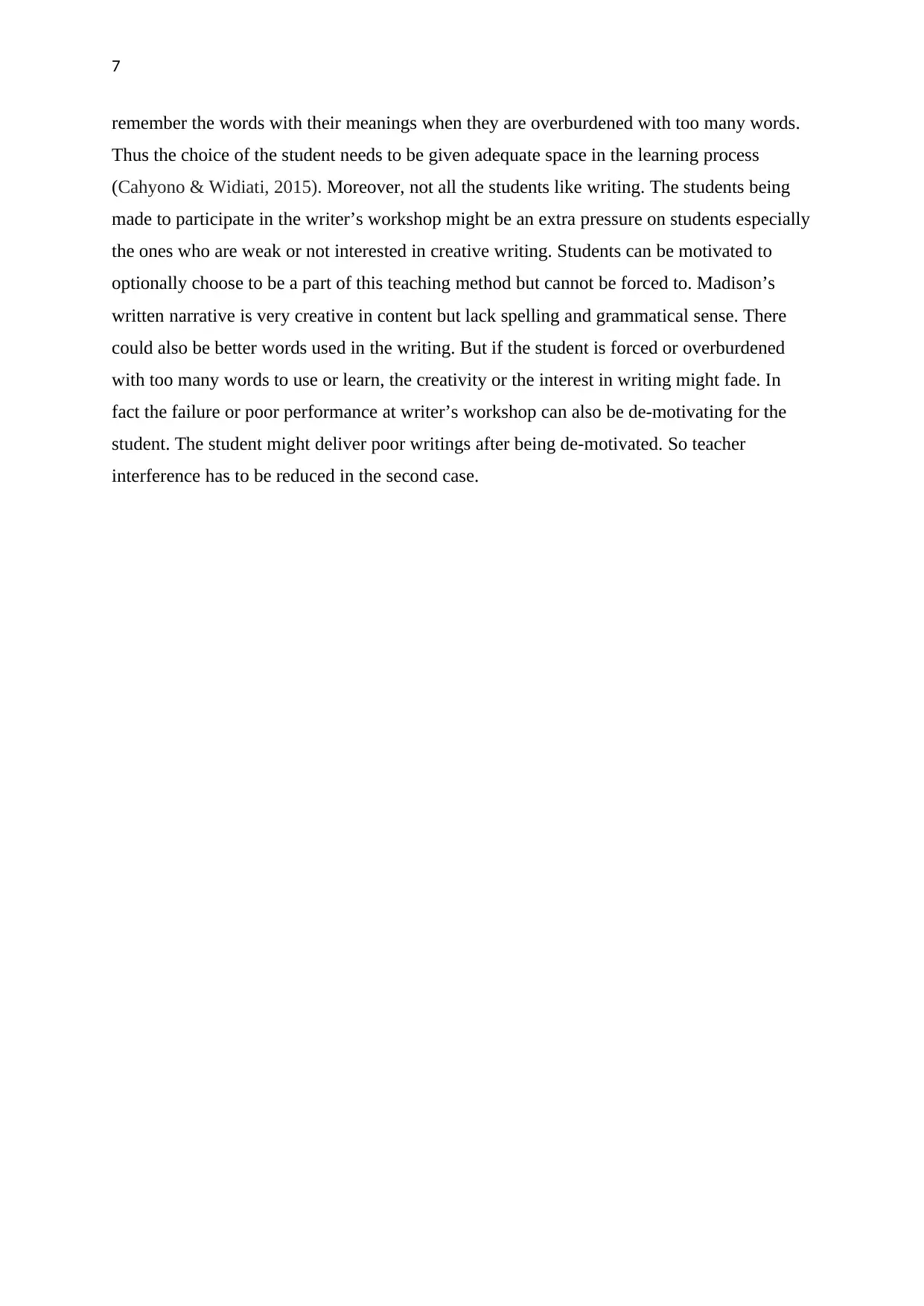
7
remember the words with their meanings when they are overburdened with too many words.
Thus the choice of the student needs to be given adequate space in the learning process
(Cahyono & Widiati, 2015). Moreover, not all the students like writing. The students being
made to participate in the writer’s workshop might be an extra pressure on students especially
the ones who are weak or not interested in creative writing. Students can be motivated to
optionally choose to be a part of this teaching method but cannot be forced to. Madison’s
written narrative is very creative in content but lack spelling and grammatical sense. There
could also be better words used in the writing. But if the student is forced or overburdened
with too many words to use or learn, the creativity or the interest in writing might fade. In
fact the failure or poor performance at writer’s workshop can also be de-motivating for the
student. The student might deliver poor writings after being de-motivated. So teacher
interference has to be reduced in the second case.
remember the words with their meanings when they are overburdened with too many words.
Thus the choice of the student needs to be given adequate space in the learning process
(Cahyono & Widiati, 2015). Moreover, not all the students like writing. The students being
made to participate in the writer’s workshop might be an extra pressure on students especially
the ones who are weak or not interested in creative writing. Students can be motivated to
optionally choose to be a part of this teaching method but cannot be forced to. Madison’s
written narrative is very creative in content but lack spelling and grammatical sense. There
could also be better words used in the writing. But if the student is forced or overburdened
with too many words to use or learn, the creativity or the interest in writing might fade. In
fact the failure or poor performance at writer’s workshop can also be de-motivating for the
student. The student might deliver poor writings after being de-motivated. So teacher
interference has to be reduced in the second case.
Paraphrase This Document
Need a fresh take? Get an instant paraphrase of this document with our AI Paraphraser
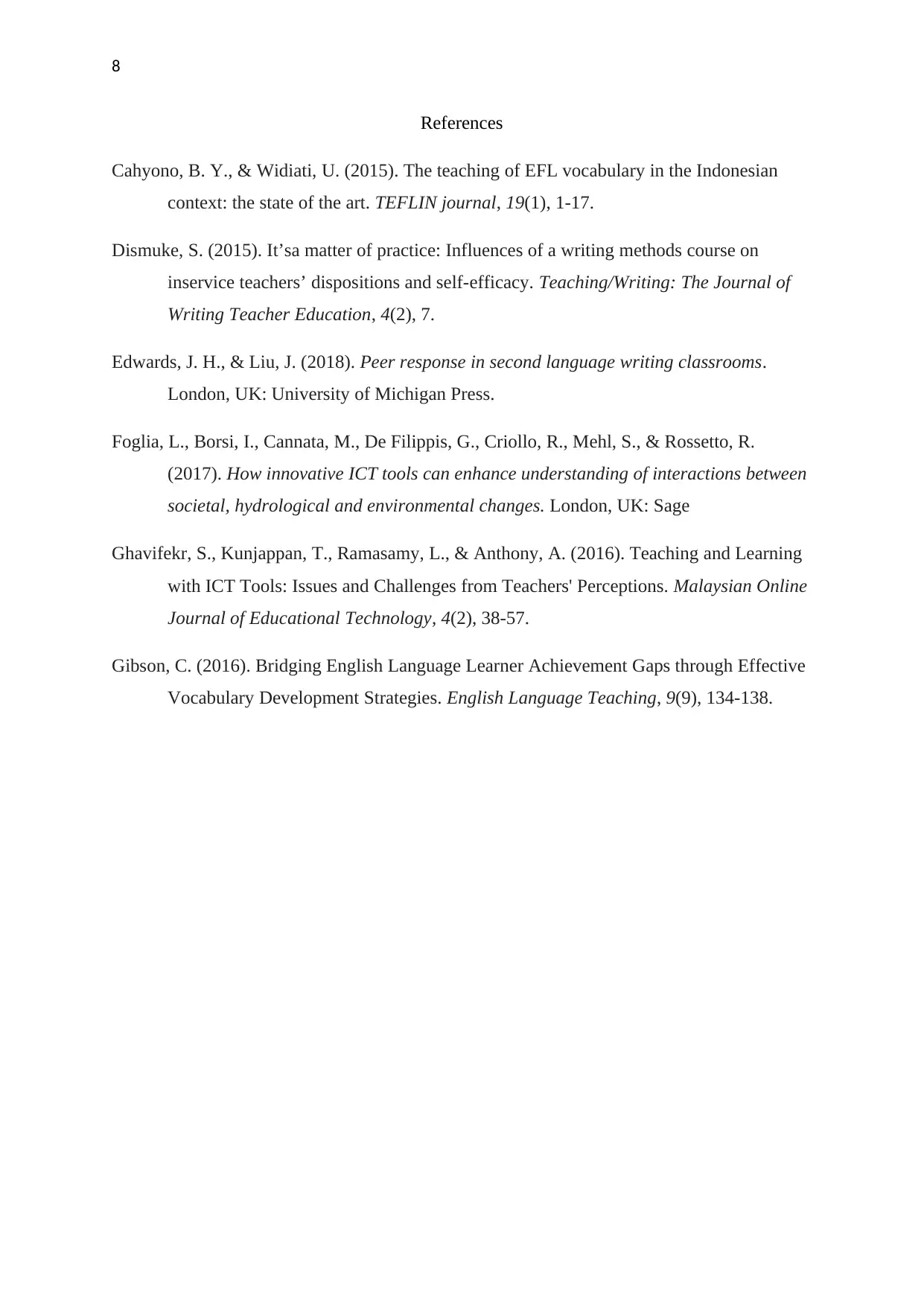
8
References
Cahyono, B. Y., & Widiati, U. (2015). The teaching of EFL vocabulary in the Indonesian
context: the state of the art. TEFLIN journal, 19(1), 1-17.
Dismuke, S. (2015). It’sa matter of practice: Influences of a writing methods course on
inservice teachers’ dispositions and self-efficacy. Teaching/Writing: The Journal of
Writing Teacher Education, 4(2), 7.
Edwards, J. H., & Liu, J. (2018). Peer response in second language writing classrooms.
London, UK: University of Michigan Press.
Foglia, L., Borsi, I., Cannata, M., De Filippis, G., Criollo, R., Mehl, S., & Rossetto, R.
(2017). How innovative ICT tools can enhance understanding of interactions between
societal, hydrological and environmental changes. London, UK: Sage
Ghavifekr, S., Kunjappan, T., Ramasamy, L., & Anthony, A. (2016). Teaching and Learning
with ICT Tools: Issues and Challenges from Teachers' Perceptions. Malaysian Online
Journal of Educational Technology, 4(2), 38-57.
Gibson, C. (2016). Bridging English Language Learner Achievement Gaps through Effective
Vocabulary Development Strategies. English Language Teaching, 9(9), 134-138.
References
Cahyono, B. Y., & Widiati, U. (2015). The teaching of EFL vocabulary in the Indonesian
context: the state of the art. TEFLIN journal, 19(1), 1-17.
Dismuke, S. (2015). It’sa matter of practice: Influences of a writing methods course on
inservice teachers’ dispositions and self-efficacy. Teaching/Writing: The Journal of
Writing Teacher Education, 4(2), 7.
Edwards, J. H., & Liu, J. (2018). Peer response in second language writing classrooms.
London, UK: University of Michigan Press.
Foglia, L., Borsi, I., Cannata, M., De Filippis, G., Criollo, R., Mehl, S., & Rossetto, R.
(2017). How innovative ICT tools can enhance understanding of interactions between
societal, hydrological and environmental changes. London, UK: Sage
Ghavifekr, S., Kunjappan, T., Ramasamy, L., & Anthony, A. (2016). Teaching and Learning
with ICT Tools: Issues and Challenges from Teachers' Perceptions. Malaysian Online
Journal of Educational Technology, 4(2), 38-57.
Gibson, C. (2016). Bridging English Language Learner Achievement Gaps through Effective
Vocabulary Development Strategies. English Language Teaching, 9(9), 134-138.
1 out of 8
Related Documents
Your All-in-One AI-Powered Toolkit for Academic Success.
+13062052269
info@desklib.com
Available 24*7 on WhatsApp / Email
![[object Object]](/_next/static/media/star-bottom.7253800d.svg)
Unlock your academic potential
Copyright © 2020–2025 A2Z Services. All Rights Reserved. Developed and managed by ZUCOL.





